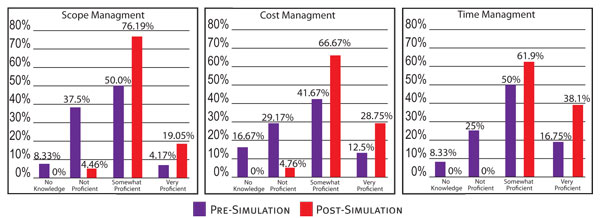Simulation Powered Learning Difference
Advantage of Simulation in Learning Project Management: The following results are from a recent graduate level study and resulting paper. The research sought to determine how students respond to the use of a simulation to learn project management.
The graphic to the right shows the results of a student survey on the impact of a simulation on various course learning objectives such as the five key project management process groups. Students provided feedback on which method of learning provided the better learning experience; the simulation, the textbook, or both.
Student comment: “I was not super familiar with Gantt charts, network diagrams, or the concept of earned value. This simulation helped me understand their functionality more fully; I have been able to understand and use these concepts more effectively in my other work as a result.”
Student proficiency in three core knowledge areas The survey question was “Rate your level of proficiency (knowledge and skills) regarding the following project management concepts”. The figure to the right shows the pre and post-simulation results.
Source: Advantage of Simulation in Online Project Management Education, Emergent Research Forum (ERF) April H. Reed, Mark Angolia, East Carolina University.
Access the full paper from the Association for Information Systems eLibrary.


Learning Retention Rates: The NTL (National Training Laboratory) Institute for Applied Behavioral Science published a study on Learning Retention Rates Findings. They found that students retain on average:

“The experts generally agree that simulations boost learning retention rates dramatically. An often-cited study conducted by the NTL Institute for Applied Behavioral Sciences in Alexandria, Va., found that on average, students retain 5 percent of what they hear in lectures, 10 percent of what they read, and 20 percent of what they see and hear in audiovisual presentations. But add “practice by doing” and “teach others/immediate use” to the mix—two learning techniques that computerized simulations possess in spades—and retention rates shoot up to a jaw-dropping 75 and 80 percent, respectively.” Simulations: The Next Generation of E-learning by Sarah Boehle.
computer simulations
SPL training includes the use of computer simulations to maximize the development and retention of new skills. The simulations give the students the ability to have “real world” practice with the tools and concepts taught in the workshops. The practice gives the participants the confidence and competence to start to use the tools and skills immediately on the job. Real life simulations require real life virtual people, and we have them. Virtual team members, stakeholders and others are just like you and me, they are all different and behave differently based on the decisions you make as you run the simulation.
This video will give you an image of what it looks like to experience SPL. As part of the training students run a virtual project through our computer simulation in teams of 4 or 5 people. The simulation gives the students the ability to have “real world” practice with the tools and concepts taught in the workshop. The practice gives the students the confidence and skill performance to start to use the tools and concepts immediately upon returning to work.
